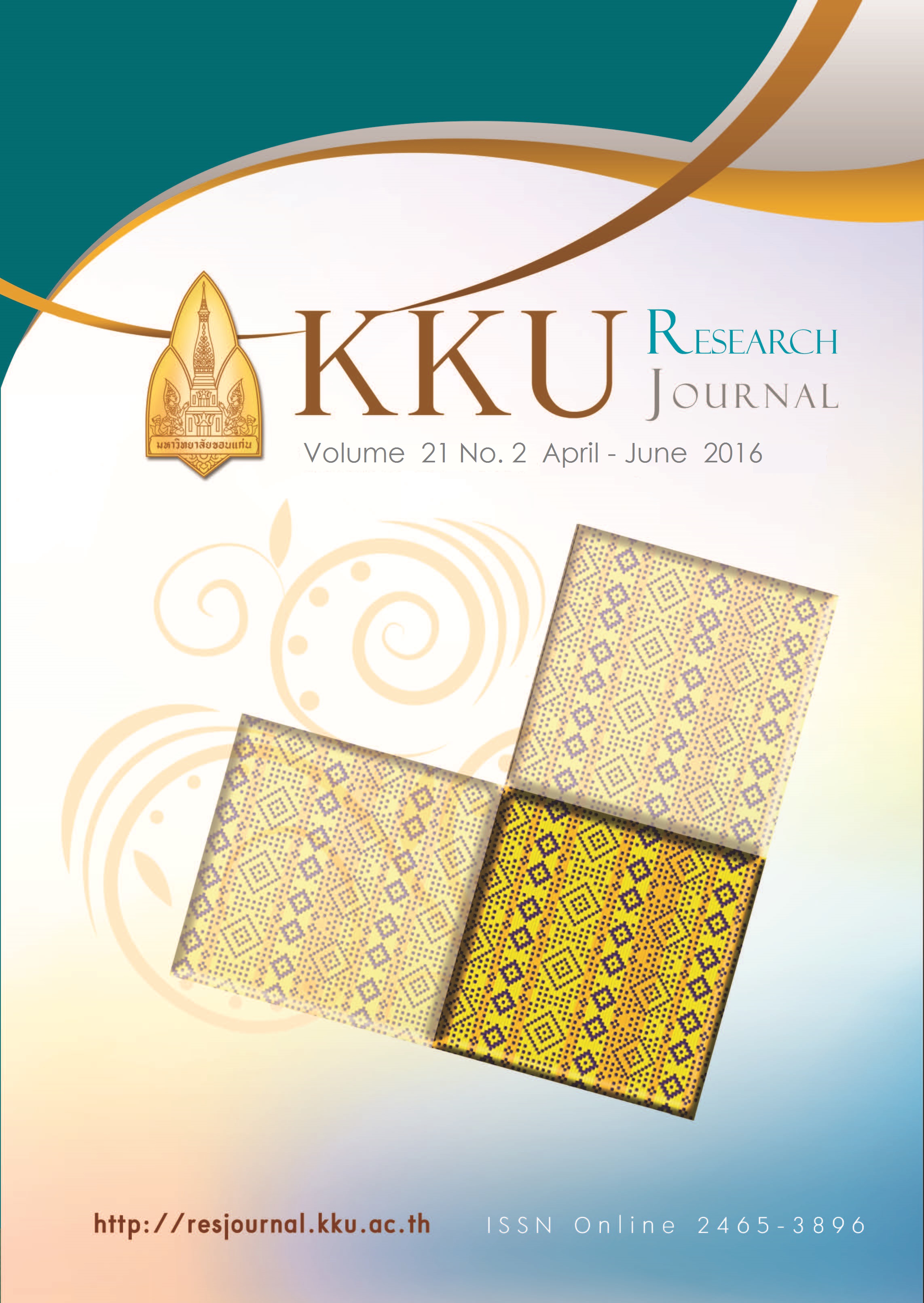Production of kefiran from molasses and spent yeast cells by lactobacillus kefiranofaciens JCM 6985
Main Article Content
Abstract
Kefiran is an exopolysaccharides produced by Lactobacillus kefiranofaciens isolated from kefir grains. Kefir grains is a starter of traditional fermented milk that originated in the Caucasian Mountains in Russia. Kefiran contains glucose and galactose at a ratio 1:1. It is widely used as thickeners, stabilizers, emulsifiers and gelling agents. It also has antimicrobial and antitumor activity. The main aim of this work was to produce kefiran from low-cost carbon and nitrogen sources. Firstly, the effect of various sugars including glucose, sucrose, lactose, galactose and lactose on kefiran production were investigated. It was found that lactose gave the highest kefiran production of 283.33±15.3 mg/L followed by glucose (210±20 mg/L) and sucrose (180±5.8 mg/L). When molasses was used as a carbon source, the optimal molasses concentration was 80 g/L which gave kefiran production of 235±5.7 mg/L. The kefiran production using various low-cost nitrogen
sources were investigated. Among nitrogen sources tested, spent yeast cells gave the highest kefiran production of 580±10 mg/L. Moreover, when spent yeast cells was
hydrolyzed and used as nitrogen source the kefiran production was increased up to 1,286±18 mg/L. These results show that molasses and spent yeast cells can be used as low-cost nutrients for kefiran production. Kefiran is an exopolysaccharides produced by Lactobacillus kefiranofaciens isolated from kefir grains. Kefir grains is a starter of traditional fermented milk that originated in the Caucasian Mountains in Russia. Kefiran contains glucose and galactose at a ratio 1:1. It is widely used as thickeners, stabilizers, emulsifiers and gelling agents. It also has antimicrobial and antitumor activity. The main aim of this work was to produce kefiran from low-cost carbon and nitrogen sources. Firstly, the effect of various sugars including glucose, sucrose, lactose, galactose and lactose on kefiran production were investigated. It was found that lactose gave the highest kefiran production of 283.33±15.3 mg/L followed by glucose (210±20 mg/L) and sucrose (180±5.8 mg/L). When molasses was used as a carbon source, the optimal molasses concentration was 80 g/L which gave kefiran production of 235±5.7 mg/L. The kefiran production using various low-cost nitrogen sources were investigated. Among nitrogen sources tested, spent yeast cells gave the highest kefiran production of 580±10 mg/L. Moreover, when spent yeast cells was hydrolyzed and used as nitrogen source the kefiran production was increased up to 1,286±18 mg/L. These results show that molasses and spent yeast cells can be used as low-cost nutrients for kefiran production.
Article Details
References
[2] Ghasemlou M, Khodaiyan F, Jahanbin K, Gharibzahedi SMT, Taheri S. Structural investigation and response surface optimisation for improvement of kefiran production yield from a low-cost culture medium. Food Chem. 2012;133:383–389.
[3] Wang M, Bi J. Modification of characteristics of kefiran by changing the carbon source of Lactobacillus kefiranofaciens. J Sci Food Agric. 2008;88:763-769.
[4] Cheirsilp B, Shimizu H, Shioya S. Modelling and optimization of environmental conditions for kefiran production by Lactobacillus kefiranofaciens. Appl Microbiol Biotechnol. 2001;57: 639-646.
[5] Witthuhn RC, Schoeman T, Britz TJ. Characterization of the microbial population at different stages of kefir production and kefir grain mass cultivation. Int Dairy J. 2005;15:383–389.
[6] Zajsek K, Gorsek A, Kolar M. Cultivating conditions effects on kefiran production by the mixed culture of lactic acid bacteria imbedded within kefir grains. Food Chem. 2013;139:970–977.
[7] Silva KR, Rodrigues SA, Filho LX, Lima AS. Antimicrobial activity of broth fermented with kefir grains. Appl Biochem Biotechnol. 2009;15:316-325.
[8] Wee YJ, Kim JN, Yun JS, Ryu HW. Utilization of sugar molasses for economical L(+)lactic acid
production by batch fermentation of Enterococcus faecalis. Enzyme Microb Technol. 2004;35:568–573.
[9] Buenaventurada PC, Tokiwa Y. Production of D-lactic acid from sugarcane molasses, sugarcane juice and sugar beet juice by Lactobacillus delbrueckii. Biotechnol Lett. 2007;29:1329–1332.
[10] Chae HJ, Joo H, In MJ. Utilization of brewer’s yeast cells for the production of food-grade yeast extract. Part 1: effects of different enzymatic treatment on solid and protein recovery and flavor characteristics. Bioresour Technol 2001;76:253-258.
[11] Champagne CP, Gaudreau H, Conway J. Effect of the production or use of mixture of baker’s or brewer’s yeast extracts on their ability to promote growth of lactobacilli and pediococci. Electron J Biotechn. 2003;6(3): 185-197.
[12] Gao MT, Hirata M, Toorisaka E, Hano T. Study on acid-hydrolysis of spent cells for lactic acid fermentation. Biochem Eng J. 2006;28:87-91.

